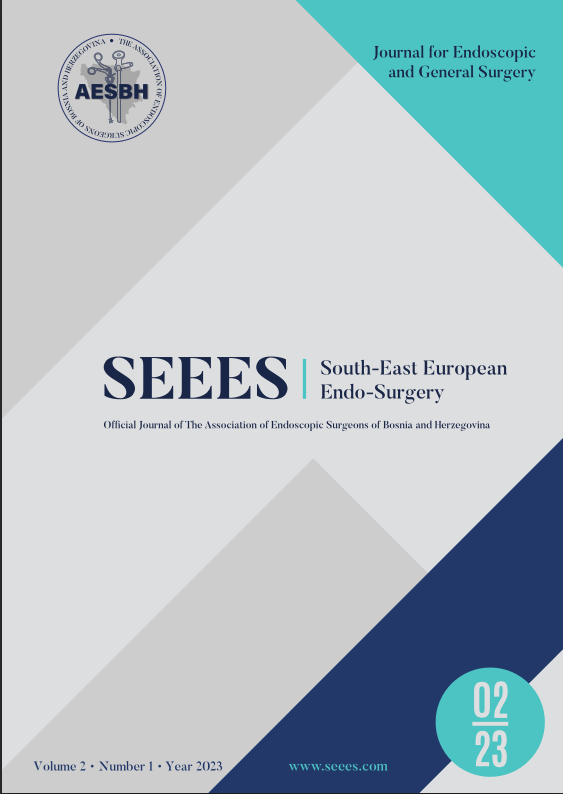The Nassar Scale as an Instrument for Predicting Conversionof Laparoscopic to Open Cholecystectomy
DOI:
https://doi.org/10.55791/s79fjc03Keywords:
cholecystectomy, laparoscopy, gallstones, surgical proceduresAbstract
Background: Difficult cholecystectomy, often associated with a heightened risk of complications, poses a significant surgical dilemma. Risk factors, such as patient age, increased body weight, the presence of gallstones, acute cholecystitis, and prior abdominal surgeries, can complicate laparoscopic cholecystectomy and necessitate conver- sion to an open procedure for safety. The aim of our study was to assess the applicability of the Nassar scale in predicting the need for conversion from laparoscopic to open cholecystectomy.
Material and methods: In our prospective cohort study, we included 85 patients who underwent either emergency or elective laparoscopic cholecystectomy between December 2021 and October 2023. The Nassar scale was used to assess the complexity of laparoscopic cholecystectomy, incorporating parameters such as ‘Gallbladder,’ ‘Cystic pedicle,’
and ‘Adhesions’ to determine a final score ranging from 1 to 5. Statistical analysis involved descriptive and analytical methods, with the significance threshold set at p < 0.05.
Results: ANOVA analysis revealed a statistically significant difference in the duration of operative procedures with different Nassar grades (p < 0.001). An increase in the Nassar grade by 1 was associated with a statistically significant
6.23-fold increase in the odds of conversion to an open procedure (p < 0.001). Receiver Operating Characteristic (ROC) analysis demonstrated a highly significant association (p < 0.001) between the Nassar grade and the conversion event, with an Area Under the Curve (AUC) of 0.881 (95% CI 0.79,0.96). The optimal cutoff value, identified as >2.5, struck a balance between sensitivity (0.86) and 1-specificity (0.23).
Conclusion: Our study underscores the utility of the Nassar scale in surgical practice. It provides valuable insights into assessing the severity of operations, facilitating informed decision-making, and optimizing treatment outcomes for patients undergoing laparoscopic cholecystectomy at our institution.
References
Jameel SM, Bahaddin MM, Mohammed AA. Grading operative findings at laparoscopic cholecystectomy following the new scoring system in duhok governorate: Cross Sectional Study. Annals of Medicine and Surgery. 2020;60:266–70. doi:10.1016/j.amsu.2020.10.035
Chandio A, Timmons S, Majeed A, Twomey A, Aftab F. Factors influencing the successful completion of laparoscopic cholecystectomy. JSLS : Journal of the Society of Laparoendoscopic Surgeons. 2009;13(4):581–6. doi:10.4293/108680809x1258998404560
Jethwani U, Singh G, Mohil R, Kandwal V, Razdan S, Chouhan J, et al. Prediction of difficulty and conversion in laparoscopic cholecystectomy. OA Minimally Invasive Surgery. 2013;1(1). doi:10.13172/2054-2666-1-1-650
Stanisic V, Milicevic M, Kocev N, Stanisic B. A prospective cohort study for prediction of difficult laparoscopic cholecystectomy. Annals of Medicine and Surgery. 2020;60:728–33. doi:10.1016/j.amsu.2020.11.082
Mushtaque M, Kema A, Khanday S, Bacha U. Difficult laparoscopic cholecystectomy and postoperative requirement of analgesics: An observational study. Saudi Journal of Laparoscopy. 2019;4(1):24. doi:10.4103/sjl.sjl_7_19
Nassar AH, Ashkar KA, Mohamed AY, Hafiz AA. Is laparoscopic cholecystectomy possible without video technology? Minimally Invasive Therapy. 1995;4(2):63–5. doi:10.3109/13645709509152757
Sah NP, Gupta RK, Awale L, Deo KB, Sah RP, Kumar A, et al. Operative difficulty grading scale for laparoscopic cholecystectomy at a tertiary care hospital in eastern Nepal. Journal of Kathmandu Medical College. 2022;58–67. doi:10.3126/jkmc.v11i1.45497
Griffiths EA, Hodson J, Vohra RS, Marriott P, Katbeh T, Zino S, et al. Utilisation of an operative difficulty grading scale for laparoscopic cholecystectomy. Surgical Endoscopy. 2018;33(1):110–21. doi:10.1007/s00464-018-6281-2
Gupta S, Anand K, Paliwal P, Baghel AS. Validation of intra-operative scoring system for difficult laparoscopic cholecystectomy. International Surgery Journal. 2022;9(11):1842. doi:10.18203/2349-2902.isj20222939
Kamal A, El-Matary M, Fadl E, Gebril N. Accuracy of randhawa and Pujahari preoperative scoring system in prediction of difficult laparoscopic cholecystectomy in Egyptian population. Ain Shams Medical Journal. 2021;72(1):163–71. doi:10.21608/asmj.2021.167373
Kaushik B, Gupta S, Bansal S, Yadav BL, Bharti D, Kalra D, et al. The role of C-reactive protein as a predictor of difficult laparoscopic cholecystectomy or its conversion. International Surgery Journal. 2018;5(6):2287. doi:10.18203/2349-2902.isj20182239
Arora BS, Sen P, Singh RK, Biswal I, Paruthy SB. HSCRP levels as predictor of difficult laparoscopic cholecystectomy- current status evaluation experience in a teaching institution. International Surgery Journal. 2017;4(4):1345. doi:10.18203/2349-2902.isj20171139
Onoe S, Maeda A, Takayama Y, Fukami Y, Kaneoka Y. A preoperative predictive scoring system to predict the ability to achieve the critical view of safety during laparoscopic cholecystectomy for acute cholecystitis. HPB. 2017;19(5):406–10. doi:10.1016/j.hpb.2016.12.013
Kutluer N. Complications during laparoscopic cholecystectomy performed due to acute cholecystitis. Laparoscopic Endoscopic Surgical Science. 2020; doi:10.14744/less.2020.25901
Kabul Gurbulak E, Gurbulak B, Akgun IE, Duzkoylu Y, Battal M, Fevzi Celayir M, et al. Prediction of the grade of acute cholecystitis by plasma level of C-reactive protein. Iranian Red Crescent Medical Journal. 2015;17(4). doi:10.5812/ircmj.17(4)2015.28091
Downloads
Published
License
Copyright (c) 2024 South-East European Endo-Surgery Journal

This work is licensed under a Creative Commons Attribution 4.0 International License.


